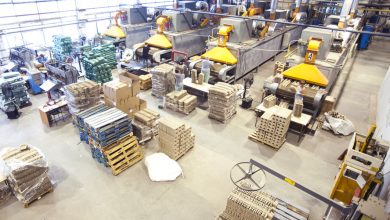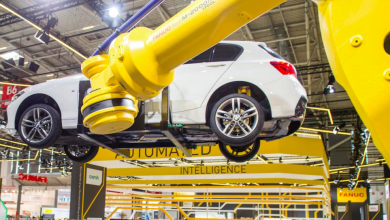Experts Explain the Future of Robotics in the Automotive Industry

The automotive industry has been using robotics since time immemorial. However, it’s only in the 21st century that technological developments are helping the industry move forward with leaps and bounds. The car manufacturing companies are counting on robots as a popular choice, owing to their flexibility and user-friendly features, which creates the future of robotics in the automotive industry. Robots work as a middle-man between conventional equipment and labour work. Here you will get an insight into how robotics has revolutionised the industry and made it more efficient.
How is Automotive Manufacturing Benefitting from Robotics?
Robotics are computer-controlled systems that perform particular activities and tasks within the factory. However, collaborative robots (Cobots) are human-operated within a work cell. The Cobots replicate human movements with their articulated hands and arms. Humans can work alongside collaborative robots in the workplace with safety protocols and sensors.
The latest range of robots counts on a series of special sensors to interact with humans and navigate the industrial unit. The fact that automotive robots can detect humans and can either stop or pause on sensing movement is by far the most amazing feature it has. It can help the automotive industry in various ways like helping to produce accessories for car, welding and so on.
How do Robots work in Automotive Industries?
The automobile industry has begun incorporating robotics in all aspects of car manufacturing. The automobile industries across the world count on collaborative automotive robotics for various activities like assembly, painting, and welding. Automotive robots play a significant role in developing autonomous cars. that’s why, these innovations are called the future of robotics in the automotive industry
Robots help in different aspects of the automotive industry like the following:
Welding
Robots complete welds precisely and can rule out all types of human mistakes. Through precise welding, robots can also improve the quality productively. The robotics can complete these tasks through cameras. The cameras offer clear visual inspection and with their sophisticated scanning system, they can also rule out the possibilities of missed out areas which demand to weld.
The scanning technology and camera inspection enables the robotics to replicate the job of experienced welders.
Painting
Robotics play a crucial role when it comes to painting. Robots can spray paint at full speed in various places. This makes robots stand as an alternative to workers who had to stand for several hours to paint and deal with toxic solvents.
The robots in comparison produce excellent quality and let the workers emphasize their core tasks. Apart from painting automobile parts, automotive robots can perform various other tasks like polishing, buffing, and sanding. While all of these tasks are risky for humans, they aren’t for robots. The robots can accomplish these tasks faster, without posing any threat to the workers’ lives.
Quality Evaluation
Robotics in the automotive industry play a significant role in quality inspection. This not only eliminates human mistakes by determining defects more efficiently than humans. But with technological advancement, robots can also carry out their tasks more precisely than before. For instance, infrared cameras can determine defects that aren’t noticeable with naked eyes. The cameras can send defective data records to mobile devices and computer systems.
Assembly
The car assembly includes components and parts attachments. Assembly is one of the important production steps. The assembly tasks are organized as per the vehicle brand and the part of the assembly. Specialized tools and machinery are used during assembly. Some tools are specially designed for particular tasks like windshields, car doors, etc.
What Makes Automotive Robotics Beneficial for the Automotive Industry?
The future of robotics in the automotive industry is going to be so beneficial, Automotive robots have been advancing in the vehicle industry for quite some time. Here are some of the advantages of using robotics in the automotive industry.
Consistency and Quality Improvements
In conjunction with other technologies such as the industrial internet of things (IIoT) and 3D printing robots, industrial robots can improve product quality and more accurate and dependable processes. Reduced cycle times and real-time monitoring are significant advantages since they help with preventative maintenance measures.
Lower Costs of Labor Investment
Many industrial activities are more costly to conduct by a human than by a robot. Using robots instead of human resources frees humans to utilise their talents and knowledge in other areas, such as engineering, programming, and maintenance, which may benefit from this strategy.
Keeping the Doors of Production Open
Some people believe machines are displacing American employees, but that isn’t always the case. In the United States, industrial robots are often used with human-assisted processes. A robot might weld pieces that are then handed over to a human to complete a job that needs a person’s intuitive “if, then” reasoning.
Increased Efficiency
Robotics boost car manufacturing procedures’ efficiency by performing different tasks simultaneously. The robotic application has helped various automotive companies in increasing their efficiencies.
Quality
Automotive robots can also boost the vehicle’s quality by minimizing the scope of human errors. Robots can both detect and resolve defects in car parts and help manufacturers to ensure their customers enjoy premium-quality products.
Safety
Robotics can increase safety when you are working around heavy-duty equipment or machinery or even inside a dangerous ambience. The robot’s programming has increased the awareness of threats that might prove dangerous to humans instance; such as molten metal and moving parts.
Deal with Complex Tasks
Robots can rule out repetitive stress injuries resulting from repetitive tasks. This is a common problem in automotive industries that counts on manual labour. Additionally, robots can deal with more difficult tasks than humans. This way they can help humans to concentrate on more urgent work. You will find robots for lifting heavy-duty components. They are designed to perform the lifting job easily without hurting or damaging themselves.
Comparatively, if humans were to accomplish this task then they might need several days to complete the task.
The Future of Robots in the Automotive Industry
The automotive industry is evolving with each passing day. The world is slowly turning fully digitized with the increase of autonomous driving popularity. Due to this, a lot of car makers are undergoing various challenges. However, a lot is happening in the robotics world. Therefore, there’s a lot more waiting in the cards; like robot valets and self-driving cars.
A lot of companies are investing in advanced technologies to cater to customer demands like machine learning and artificial intelligence. In the future robots will produce safer cars more efficiently.
The future of robots in the automotive industry is very promising indeed. Robots play a crucial role in different aspects of the automotive industry. They play significant toles during final car parts assembly, welding, painting and collaboration with humans to produce car accessories.
The best way to move the automobile industry forward is to incorporate robots and make humans work along their sides. You can program the robots and make them handle different tasks for prolonger hours without having to worry about their tiredness. Plus, employees can easily supervise the robots when needed. The future of robotics in the automotive industry looks safe and good, given how the robots are equipped with warning devices and build-in safety.
Must Read: There are lots of most expensive cars in the world, but only one that is considered to be the most expensive car in the world.




